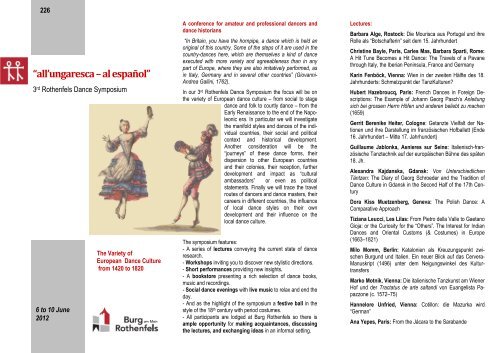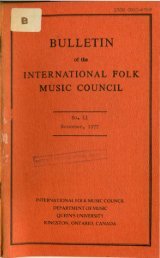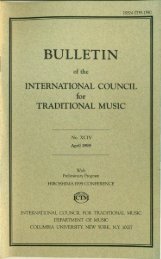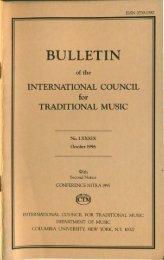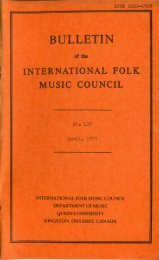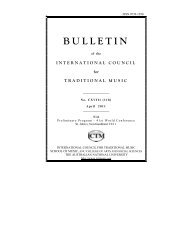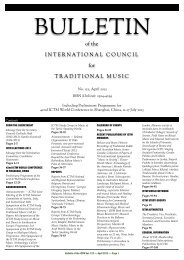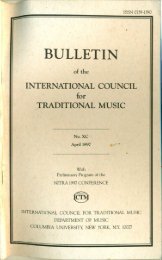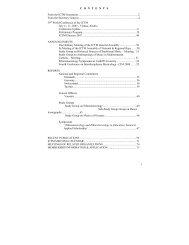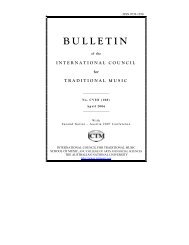all'ungaresca – Al Español
all'ungaresca – Al Español
all'ungaresca – Al Español
You also want an ePaper? Increase the reach of your titles
YUMPU automatically turns print PDFs into web optimized ePapers that Google loves.
226<br />
“all’ungaresca <strong>–</strong> al español”<br />
3 rd Rothenfels Dance Symposium<br />
6 to 10 June<br />
2012<br />
The Variety of<br />
European Dance Culture<br />
from 1420 to 1820<br />
A conference for amateur and professional dancers and<br />
dance historians<br />
“In Britain, you have the hornpipe, a dance which is held an<br />
original of this country. Some of the steps of it are used in the<br />
country-dances here, which are themselves a kind of dance<br />
executed with more variety and agreeableness than in any<br />
part of Europe, where they are also imitatively performed, as<br />
in Italy, Germany and in several other countries” (Giovanni-<br />
Andrea Gallini, 1762).<br />
In our 3 rd Rothenfels Dance Symposium the focus will be on<br />
the variety of European dance culture <strong>–</strong> from social to stage<br />
dance and folk to courtly dance <strong>–</strong> from the<br />
Early Renaissance to the end of the Napoleonic<br />
era. In particular we will investigate<br />
the manifold styles and dances of the individual<br />
countries, their social and political<br />
context and historical development.<br />
Another consideration will be the<br />
“journeys” of these dance forms, their<br />
dispersion to other European countries<br />
and their colonies, their reception, further<br />
development and impact as “cultural<br />
ambassadors” or even as political<br />
statements. Finally we will trace the travel<br />
routes of dancers and dance masters, their<br />
careers in different countries, the influence<br />
of local dance styles on their own<br />
development and their influence on the<br />
local dance culture.<br />
The symposium features:<br />
- A series of lectures conveying the current state of dance<br />
research.<br />
- Workshops inviting you to discover new stylistic directions.<br />
- Short performances providing new insights.<br />
- A bookstore presenting a rich selection of dance books,<br />
music and recordings.<br />
- Social dance evenings with live music to relax and end the<br />
day.<br />
- And as the highlight of the symposium a festive ball in the<br />
style of the 18 th century with period costumes.<br />
- <strong>Al</strong>l participants are lodged at Burg Rothenfels so there is<br />
ample opportunity for making acquaintances, discussing<br />
the lectures, and exchanging ideas in an informal setting.<br />
Lectures:<br />
Barbara <strong>Al</strong>ge, Rostock: Die Mourisca aus Portugal und ihre<br />
Rolle als “Botschafterin” seit dem 15. Jahrhundert<br />
Christine Bayle, Paris, Carles Mas, Barbara Sparti, Rome:<br />
A Hit Tune Becomes a Hit Dance: The Travels of a Pavane<br />
through Italy, the Iberian Peninsula, France and Germany<br />
Karin Fenböck, Vienna: Wien in der zweiten Hälfte des 18.<br />
Jahrhunderts: Schmelzpunkt der TanzKulturen?<br />
Hubert Hazebroucq, Paris: French Dances in Foreign Descriptions:<br />
The Example of Johann Georg Pasch’s Anleitung<br />
sich bei grossen Herrn Höfen und anderen beliebt zu machen<br />
(1659)<br />
Gerrit Berenike Heiter, Cologne: Getanzte Vielfalt der Nationen<br />
und ihre Darstellung im französischen Hofballett (Ende<br />
16. Jahrhundert <strong>–</strong> Mitte 17. Jahrhundert)<br />
Guillaume Jablonka, Asnieres sur Seine: Italienisch-französische<br />
Tanztechnik auf der europäischen Bühne des späten<br />
18. Jh.<br />
<strong>Al</strong>exandra Kajdanska, Gdansk: Von Unterschiedlichen<br />
Täntzen: The Diary of Georg Schroeder and the Tradition of<br />
Dance Culture in Gdansk in the Second Half of the 17th Century<br />
Dora Kiss Muetzenberg, Geneva: The Polish Dance: A<br />
Comparative Approach<br />
Tiziana Leucci, Les Lilas: From Pietro della Valle to Gaetano<br />
Gioja: or the Curiosity for the “Others”. The Interest for Indian<br />
Dances and Oriental Customs (& Costumes) in Europe<br />
(1663<strong>–</strong>1821)<br />
Milo Momm, Berlin: Katalonien als Kreuzungspunkt zwischen<br />
Burgund und Italien. Ein neuer Blick auf das Cervera-<br />
Manuskript (1496) unter dem Neigungswinkel des Kulturtransfers<br />
Marko Motnik, Vienna: Die italienische Tanzkunst am Wiener<br />
Hof und der Tractatus de arte saltandi von Euangelista Papazzone<br />
(c. 1572<strong>–</strong>75)<br />
Hannelore Unfried, Vienna: Cotillon: die Mazurka wird<br />
“German”<br />
Ana Yepes, Paris: From the Jácara to the Sarabande
Workshops:<br />
Anne Daye, London: The French Contredanse in England,<br />
Scotland and Ireland<br />
Dora Kiss-Muetzenberg, Geneva: The Polish Dance<br />
Carles Mas, Paris: The Iberian Pavana by Jaque<br />
Anna Karin Ståhle, Lindigö: La Escuela Bolera<br />
Hannelore Unfried, Wien: Gestampft, Geschlagen, Gewählt -<br />
Mazurka im frühen 19. Jahrhundert<br />
Nicoline Winkler, Eberbach: Das Repertoire der Pariser<br />
Opernbälle im frühen 18. Jahrhundert<br />
Social Dance Evenings:<br />
Ingo Günther, Berlin: Der Figurenländler des 18. Jh.<br />
<strong>Al</strong>an Jones, Paris: Spanish Minuet Improvisation<br />
Jørgen Schou-Pedersen, Copenhagen, Uwe Schlottermüller,<br />
Freiburg: Budapest, Cairo, Peking <strong>–</strong> On the Road<br />
with Dubreil and Delpêch<br />
Short Performances:<br />
BarockTanzEnsemble contretem(p)s berlin: Scenes from<br />
Lambranzi’s “Curieuse Theatralische Tantzschul”<br />
Cracovia Danza, Cracow: “Ballet des Nations”<br />
Irène Ginger, Hubert Hazebroucq, Paris: “A Few Metamorphoses<br />
of the Minuet”<br />
Ana Yepes, Paris: Spanish Baroque Dances<br />
Additional features:<br />
- a bulletin board to display information: performances,<br />
courses, publications, etc. (bring sufficient<br />
copies for distribution)<br />
- a conference proceedings volume containing the<br />
lectures<br />
Conference languages: German and English<br />
What to bring:<br />
- comfortable clothing and dance shoes<br />
- For the ball: dressy attire or an 18th century<br />
costume<br />
Scientific Committee:<br />
Barbara Sparti (dance scholar, author of numerous publications<br />
on Renaissance Dance)<br />
Prof. Carol G. Marsh (musicologist, co-author of Musical<br />
Theatre at the Court of Louis XIV)<br />
Jørgen Schou-Pedersen (music pedagogue, dance researcher<br />
and dance pedagogue)<br />
Uwe Schlottermüller (editor of Instruction pour dancer, J.G.<br />
Pasch: Anleitung sich bei grossen Herrn Höfen und anderen<br />
beliebt zu machen, 1659)<br />
Markus Lehner (author of A Manual of Sixteenth-century<br />
Italian Dance Steps)<br />
For further information, please contact:<br />
Markus Lehner, Mühlfelder Str. 18b, D-82211 Herrsching<br />
Tel. 0049-(0)8152-5248, Fax. 08152-981509<br />
Email: markus.lehner@online.de<br />
Detailed information about the program, the presenters, and<br />
the conference center can be found at www.burgrothenfels.de.<br />
Conference number: 226<br />
Begins: Wednesday, 6 June 2012<br />
with dinner at 6:30 pm<br />
registration and check-in from 3 pm<br />
Ends: Sunday, 10 June 2012<br />
with lunch at 12:30 pm<br />
Accommodation and meals per person for the entire<br />
conference:<br />
Single room € 219.-<br />
Double room € 190.-<br />
Quadruple room € 167.-<br />
Dormitory room € 140.- (students)<br />
Conference registration:<br />
€ 220.- (regular) € 140.- (students)<br />
Part-time enrolment is not possible. Registration is limited<br />
to 80 participants. Prompt registration is recommended.<br />
Send your written registration request to:<br />
Verwaltung Burg Rothenfels, 97851 Rothenfels,<br />
Tel. 0049-(0)9393-99999, Fax. 09393-99997<br />
Email: verwaltung@burg-rothenfels.de<br />
Web: www.burg-rothenfels.de<br />
Registration may be made by mail or Internet.<br />
Reduced fees for dormitory rooms and conference registration<br />
are available for currently enrolled students and the unemployed.<br />
Early registration: A 10 euro rebate will be applied to registrations<br />
received prior to April 21 2008.<br />
Cancellation fee: the reduced conference registration fee will<br />
be charged for cancellation 7 days or less before the beginning<br />
of the symposium.<br />
Terms: The Burg Rothenfels administration assumes no<br />
liability for accidents or injuries sustained during the conference.<br />
Location: Burg Rothenfels lies on the Main River between<br />
Lohr and Wertheim. It can be reached by train (to Lohr,<br />
Gemünden, or Wertheim) and then by bus (at the bus stop<br />
“Bergrothenfels”); by car (Autobahn A3), take the exit Marktheidenfeld<br />
or Rohrbrunn. Further details and car-pooling<br />
information can be found on the Burg Rothenfels website.<br />
Please include in your registration:<br />
- Name/address/telephone or e-mail<br />
- Symposium number and short title<br />
- your choice of accommodation


